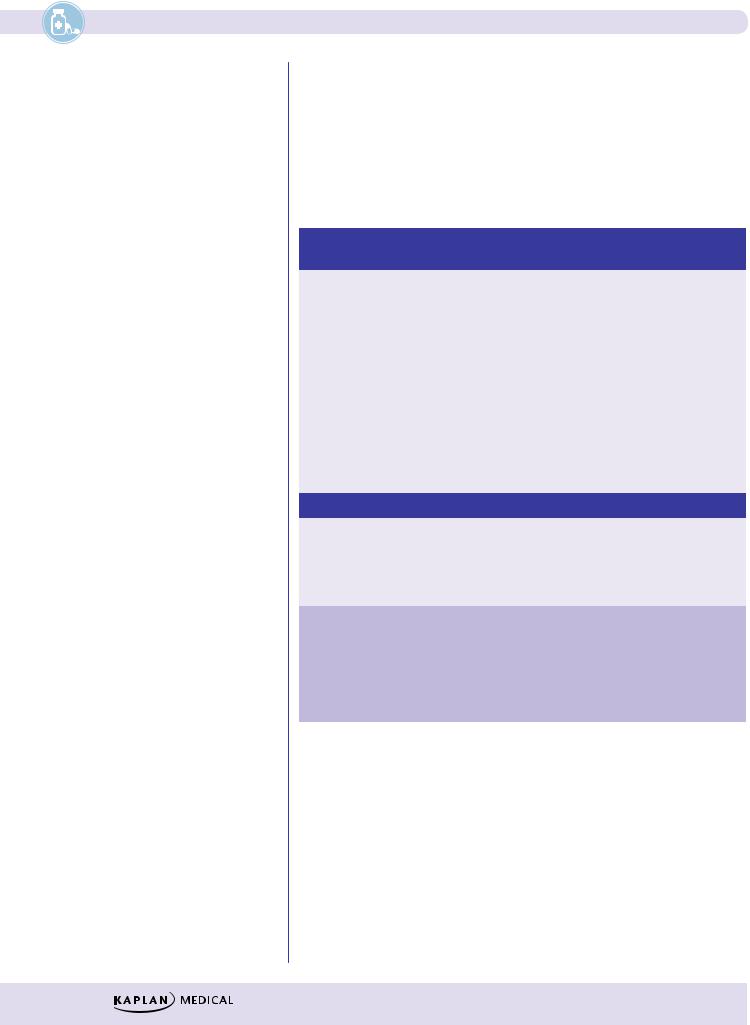
книга / 2016_Kaplan_USMLE_Step_1_Lecture_Notes_Pharmacology
.pdf

Section IV λ CNS Pharmacology
λPharmacokinetics of morphine:
−Glucuronidation
−Morphine-6-glucuronide is highly active
−Caution in renal dysfunction
λOther opioids and analgesics (see Table IV-7-1).
|
Table IV-7-1. Other Opioids and Analgesics |
|||||
|
|
|
|
|
|
|
|
|
Receptor |
|
Drug |
|
Characteristics |
|
|
Action |
|
|
|
|
Clinical Correlate |
|
Full agonists |
|
Meperidine |
|
λ Also antimuscarinic |
Seizures caused by meperidine cannot |
|
|
|
|
|
No miosis |
|
|
|
|
|
Tachycardia |
|
be treated with opioid antagonists; use |
|
|
|
|
|
|
|
|
|
|
|
No spasm GI/GU/gallbladder |
|
benzodiazepines |
|
|
|
|
|
|
|
|
|
|
|
λ Metabolized by cytochrome P450 to |
|
|
|
|
|
|
|
|
|
|
|
|
|
|
normeperidine, a serotonin reuptake |
|
|
|
|
|
|
inhibitor; normeperidine may cause |
|
|
|
|
|
|
serotonin syndrome and seizures |
|
|
|
|
Methadone |
|
λ Used in maintenance of opiate addict |
|
|
|
|
Codeine |
|
λ Cough suppressant |
|
|
|
|
|
|
λ Analgesia |
|
|
|
|
|
|
λ Used in combination with NSAIDs |
|
|
Partial agonist |
|
Buprenorphine |
|
• Precipation of withdrawal |
|
|
Mixed agonist- |
|
Nalbuphine, |
|
λ κ agonist |
|
|
antagonists |
|
pentazocine |
|
spinal analgesia |
|
|
|
|
|
|
dysphoria |
|
|
|
|
|
|
λ µ antagonist |
|
|
|
|
|
|
precipitation of withdrawal |
|
|
Antagonists |
|
Naloxone |
|
λ IV, reversal for respiratory depression |
|
|
|
|
Naltrexone |
|
λ PO, ↓ craving for alcohol and used in |
|
|
|
|
|
|
opiate addiction |
|
|
|
|
Methylnaltrexone λ Treatment of opioid-induced |
||
|
|
|
|
|
|
constipation (does not cross BBB and |
|
|
|
|
|
|
won’t precipitate withdrawal) |
λSide effects of opioid analgesics:
−Acute toxicity: classic triad
ºPinpoint pupils
ºRespiratory depression
ºComa
−Management of acute toxicity:
ºSupportive
ºIV naloxone
160

Chapter 7 λ Opioid Analgesics
λAbuse liability of opioid analgesics:
−Tolerance: pharmacodynamic; occurs to all effects, except miosis and constipation
−Dependence: physical and psychologic
−Withdrawal:
ºYawning
ºLacrimation, rhinorrhea, salivation
ºAnxiety, sweating, goose bumps
ºMuscle cramps, spasms, CNS-originating pain
−Management of withdrawal:
ºSupportive
ºMethadone
ºClonidine
λOpiate-related drugs with specific indications
−Loperamide: diarrhea
−Dextromethorphan: cough
Chapter Summary
λOpioid agonists and/or antagonists act in part by binding to the receptors for the endogenous opiopeptides. These are G-protein–linked, multisubunit structures to which the various opioids bind as full or partial agonists or as antagonists. The resultant complex array of potential mechanisms, sites of action, types of effects, kinetics, and contraindications are discussed.
λTable IV-7-1 summarizes the receptor actions and other relevant characteristics of 8 opioid drugs.
161

Drugs of Abuse |
8 |
Learning Objectives
Provide an overview of the main classes of medications that are abused and controlled
Give examples of drugs in each class and describe their effect, toxicity, and withdrawal response
DRUGS OF ABUSE
Table IV-8-1. Properties of Drugs of Abuse
CNS Stimulants |
Cocaine |
Amphetamines |
Neurotransmitters |
|
NE, DA, 5HT |
involved |
|
|
Mechanism(s) of |
Blocks DA, NE, and 5HT |
Blockade of reuptake of NE and DA, release amines from mobile |
action |
reuptake in CNS; local |
pool, weak MAO inhibitors |
|
anesthetic action from |
|
|
Na+ channel blockade |
|
Effects |
1. Increase NE: sympathomimetic effect with increased heart rate and contractility, blood pressure |
|
|
changes, mydriasis, and central excitation, hyperactivity |
|
|
2. Increase DA: psychotic episodes, paranoia, hallucinations, possible dyskinesias, and endocrine |
|
|
disturbances |
|
|
3. Increase 5HT: behavioral changes, aggressiveness, dyskinesias, and decreased appetite |
|
Toxicity |
1. Excess NE: cardiac arrhythmias, generalized ischemia with possible MI and strokes; acute renal and |
|
|
hepatic failures |
|
|
2. Excess DA: major psychosis, cocaine delirium |
|
|
3. Excess 5HT: possible serotonin syndrome |
|
|
4. All of the above: convulsion, hyperpyrexia, and death |
|
Withdrawal |
Craving, severe depression, anhedonia, anxiety; manage with antidepressants |
|
(Continued)
163

Section IV λ |
CNS Pharmacology |
|
|
Table IV-8-1. Properties of Drugs of Abuse (continued) |
|
||
CNS Depressants |
Benzodiazepines |
|
Barbiturates and Ethanol |
Neurotransmitters involved |
GABA |
||
Mechanism of |
Potentiation of GABA interaction |
Prolongation of GABA, GABA mimetic at high doses, on GABAA |
|
action |
with GABAA receptors |
|
receptors |
|
involves BZ1 and BZ2 binding sites |
|
|
Effects |
Light to moderate CNS depression |
Any plane of CNS depression |
|
Toxicity |
Sedation, anterograde |
|
Severe CNS depression, respiratory depression, and death |
|
amnesia; in severe OD |
|
|
|
(or IV use), reverse |
|
|
|
with flumazenil |
|
|
Withdrawal |
Rebound insomnia, rebound |
|
Agitation, anxiety, hyperreflexia, and life-threatening |
|
anxiety |
|
seizures + in ethanol withdrawal delusions/ hallucinations— |
|
|
|
delirium tremens (DTs) |
Opioids |
Morphine, Heroin, Methadone, Fentanyls, Other Opioids |
||
Neurotransmitters |
NE, DA, 5HT, GABA, and many others |
|
|
involved |
|
|
|
Mechanism of |
Activate opioid µ, κ, and δ receptors. Potent µ receptor activators have the most intense abuse and |
||
action |
dependence liability, possibly effected via an increase in dopaminergic transmission in the mesolimbic |
||
|
tracts |
|
|
Effects |
Euphoria, analgesia, sedation, cough suppression, and constipation; strong miosis (except meperi- |
||
|
dine) |
|
|
Toxicity |
Severe respiratory depression (reverse with naloxone), nausea, vomiting |
||
Withdrawal |
Lacrimation, yawning, sweating, and restlessness, rapidly followed with centrally |
||
|
originating pain, muscle cramping, and diarrhea; not life-threatening |
||
Hallucinogens |
Marijuana |
|
Hallucinogens |
Neurotransmitters |
Many |
|
5HT |
involved |
|
|
|
Mechanism of |
Interaction of THC with CB1 and |
|
Interaction with several subtypes of 5HT receptors |
action |
CB2 cannabinoid receptors in CNS |
|
|
|
and periphery |
|
|
Effects |
Sedation, euphoria, ↑ HR, |
|
Hallucinogen, sympathomimetic, |
|
conjunctival irritation, delusions, |
causes dysesthesias |
|
|
hallucinations |
|
|
Toxicity |
Associated with smoking, possible |
Poorly described, flashbacks likely |
|
|
flashbacks |
|
|
Withdrawal |
Irritability, anxiety |
|
Poorly characterized |
Miscellaneous Abused Drugs
1.PCP: NMDA-receptor antagonist; extremely toxic, horizontal and vertical nystagmus, paranoia, rhabdomyolysis; overdose is common, with convulsions and death
2.Ketamine: similar to but milder than PCP, with hallucinations, glutamate-receptor antagonist
3.Anticholinergics: scopolamine, atropine-like
4.MDMA (“Ecstasy”), MDA, MDEA: amphetamine-like with strong 5HT pharmacology and therefore hallucinogenic; generally neurotoxic
5.Inhalants: solvent abuse, multiple organ damage; see Toxicology, section XI
164

Chapter 8 λ Drugs of Abuse
Chapter Summary
λTable IV-8-1 summarizes the properties of drugs of abuse. These include the CNS stimulants (cocaine and amphetamines), the CNS depressants
(benzodiazepines, barbiturates, and ethanol), the opioids (morphine, heroin, methadone, fentanyl, and others), the hallucinogens (marijuana and other hallucinogens), PCP, ketamine, anticholinergics (scopolamine), MDMA-MDA- MDEA (all amphetamine-like), and inhalants.
165


Section IV λ CNS Pharmacology
1.Lorazepam can be safely used as a preanesthetic medication in a patient undergoing liver transplantation without fear of excessive CNS depression because the drug is
A.excreted in unchanged form
B.actively secreted into the GI tract
C.conjugated extrahepatically
D.a selective anxiolytic devoid of CNS depressant actions
E.reversible by naloxone
2.Midazolam is an effective anesthetic because it acts by
A.increasing functional activity at GABAB receptors
B.enhancing the actions of dopamine
C.blocking the NMDA glutamate receptor subtype
D.acting as a partial agonist at 5HT receptors
E.facilitating GABA-mediated increases in chloride ion conductance
3.Which one of the following is an established clinical use of morphine?
A.Management of generalized anxiety disorders
B.Relief of pain associated with biliary colic
C.Pulmonary congestion
D.Treatment of cough associated with use of ACE inhibitors
E.Suppression of the ethanol withdrawal syndrome
4.A 40-year-old man was given a drug that binds to a subunit of the GABAA receptor. When used at a high dose, the drug can open Cl– channels independent of GABA. What drug was the man given?
A.Diazepam
B.Ethanol
C.Phenobarbital
D.Baclofen
E.Dronabinol
5.Which one of the following is characteristic of both phenytoin and carbamazepine?
A.Inhibition of hepatic cytochrome P450
B.First-order elimination at high therapeutic doses
C.Enhances the effects of oral contraceptives
D.Safe to use in pregnancy
E.Prevent sodium influx through fast sodium channels
168
